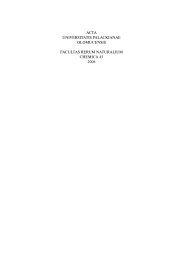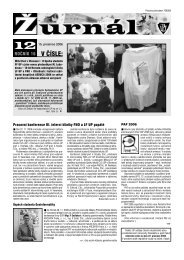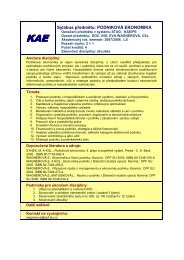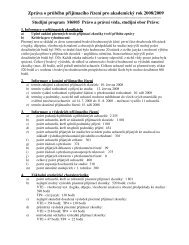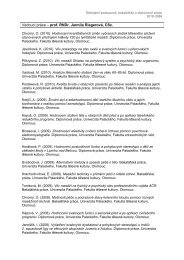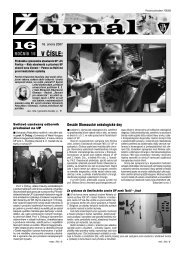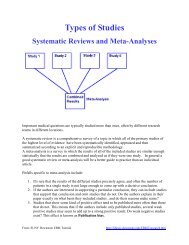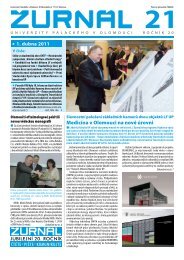ACTA UNIVERSITATIS PALACKIANAE OLOMUCENSIS GYMNICA ...
ACTA UNIVERSITATIS PALACKIANAE OLOMUCENSIS GYMNICA ...
ACTA UNIVERSITATIS PALACKIANAE OLOMUCENSIS GYMNICA ...
- No tags were found...
You also want an ePaper? Increase the reach of your titles
YUMPU automatically turns print PDFs into web optimized ePapers that Google loves.
Acta Univ. Palacki. Olomuc., Gymn. 2004, vol. 34, no. 2 19POSTURE ASSESSMENT IN CHILDREN OF THE SCHOOL AGE GROUP(7–15 YEARS OF AGE) IN THE OLOMOUC REGIONMiroslav KopeckýPedagogical Faculty, Palacký University, Olomouc, Czech RepublicSubmitted in February, 2004Within the framework of anthropological research, the diagnosis of posture using the Jaroš & Lomíček somatoscopicmethod (1957) was carried out in a set of 1201 children of school age as well as foot arch assessment using plantogramsas suggested by Klementa (1987). The posture assessment results imply a continuing unfavorable trend of functionaldisorders of the locomotive system in the present childhood population. Defective posture has been diagnosed in 56%of boys and 37% of girls. The author finds the main cause of the defective posture in the occurrence of muscular dysbalances,namely the upper and lower crossed syndromes. The posture disorders manifest themselves in keeping thehead stuck forward, round shoulders, shoulder blades standing out, high pelvis inclination accompanied with lumberlordosis, and in many cases with loose abdominal muscles.The condition of the foot arch is relatively satisfactory, as the normal foot arch has been found in 85% of theprobands.Keywords: School age group, posture, somatoscopic method, defective posture, muscular dysbalances, foot arch, Olomoucregion.INTRODUCTIONThe increasing occurrence of defective posture accompaniedby the insufficient fitness of present childrenand teenagers cannot leave us unconcerned, consideringthe fact that if not diagnosed and rectified in time, thesedefects can lead to serious disorders requiring medicaltreatment. Naturally, the defects of statics, dynamics anddefective posture have also appeared in the past, but thepresent occurrence is substantially higher. This negativetrend is mentioned in studies by Riegerová et al. (1993),Přidalová (1997), Jankovská (1998), and Kolisko andJandová (2002). According to Kubát (1975), defectiveposture in school age children appears in 50% of thepopulation and Picek (1986) states that defective posturecan be found in 85% of our children. The increasingnumber of children with defective posture, spinal disorders,small deformations and bad locomotive stereotypesis probably in relationship not only to the acceleration ofgrowth and development of the present population, butalso with an insufficient amount of movement stimuli,excessive static stress, or one-sided and improper bodyload, tiredness, excessive sitting and at last but not leastwith psychological stress. The conditions that influenceor cause defective posture do not affect children separatelybut they mingle and influence one another, whichallows us to speak about multifactorial agents.The mechanical understanding of the origin of defectiveposture has become a thing of the past. At present,we understand defective posture as a manifestation ofa certain muscular dysbalance. Muscular dysbalancesappear between two basic groups of skeletal musclesthat may be found on the front as well as the rear partof the human body. From this point of view, we differentiatetonic muscles (postural, antigravitational), thatfunction more statically with prevailing isometric contraction,and phasic muscles (phasic, locomotive) withprevailing dynamic function accompanied by isotoniccontraction. The origin of muscular dysbalance oftenmanifests itself in, and is also more or less accompaniedby, defects of locomotive stereotypes. The most seriouschange occurring in muscular dysbalance is muscularshortening. The static and dynamic functions of thelocomotive system are caused by the imbalance of thepostural muscle that tends to stiffen and phasic musclethat tends to slacken. If the hypertrophic posturalmuscles overwhelm the phasic muscles that tend toslacken the respective part of the body, it is affectedby the defective posture. The most frequent types ofslackness result from muscular dysbalances. Musculardysbalances most often occur: in the area of the pelvisand lower limbs (important regarding static function),in the area of the upper trunk, neck and head, and inthe area of the lower limbs. Defective posture is characterizedby the absence of morphological changes inthe skeleton, and it is important that defective postureand its deviations may be rectified by deliberate effort.Therefore, the primary disorder is that of the neuromuscularsystem and central nervous system. Whendiagnosing muscular dysbalances and deviations from



